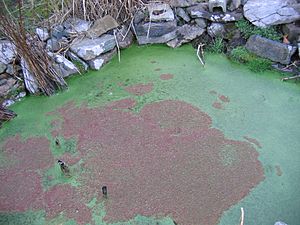Carolina mosquitofern facts for kids
Quick facts for kids Carolina mosquitofern |
|
|---|---|
 |
|
| Azolla cristata (reddish) and Lemna (green) in a small pool | |
| Conservation status | |
| Scientific classification | |
| Genus: |
Azolla
|
| Species: |
cristata
|
| Synonyms | |
|
Synonyms of A. cristata include:
|
|
Azolla cristata , also known as the Carolina mosquitofern or water velvet, is a cool little plant that floats on water. It's a type of fern that loves freshwater. You can find it naturally in many parts of the Americas. This includes places like eastern North America, from southern Ontario down to Texas. It also grows in the Caribbean and across Central and South America, all the way to northern Argentina.
This aquatic fern has tiny, scale-like leaves called fronds. They are usually about 5–10 mm long. Their color can change from green to reddish, especially when they get lots of sunlight or during winter. The fronds are covered in tiny bumps called trichomes. These trichomes make the plant look and feel like soft velvet. Azolla cristata is super special because it can pull nitrogen from the air. It does this with the help of tiny cyanobacteria that live inside it. This process is called nitrogen fixation. The plant can handle cold winter water temperatures around 5 °C (41 degrees Fahrenheit). But it grows best in summer when the water is between 25–30 °C (77-86 degrees Fahrenheit).
How to Identify This Plant
It can be tricky to tell Azolla cristata apart from a similar plant called Azolla filiculoides. The best way to be sure is to look closely at the tiny bumps on its leaves. These bumps are called trichomes. They help the plant resist water. In A. filiculoides, these trichomes are made of just one cell. But in A. cristata, they are made of two cells, which means they are "septate."
Its Name Story
For a long time, this plant was known by the name Azolla caroliniana. However, some scientists named Evrard and Van Hove did research and found something interesting. They discovered that the original plant specimen used to describe A. caroliniana was actually Azolla filiculoides. This meant the name caroliniana was being used incorrectly for Azolla cristata. So, its proper scientific name is now Azolla cristata.
Growing and Using Azolla
Azolla cristata is very important in farming, especially in southern and eastern Asia. Farmers use it as a "bio-fertilizer." This is because of its amazing ability to fix nitrogen from the air. When grown with crops like rice, it adds natural fertilizer to the soil. This means farmers don't need to add as much artificial fertilizer.
When Azolla cristata grows, it forms a thick mat of leaves on the water. This mat can be up to 4 cm thick. This thick layer also helps to stop weeds from growing, which is great for crops. Farmers also harvest the fronds to feed fish and poultry. You might also see Azolla cristata in aquariums or outdoor ponds. It's a popular floating plant and is easy to grow by simply dividing it into smaller pieces.




